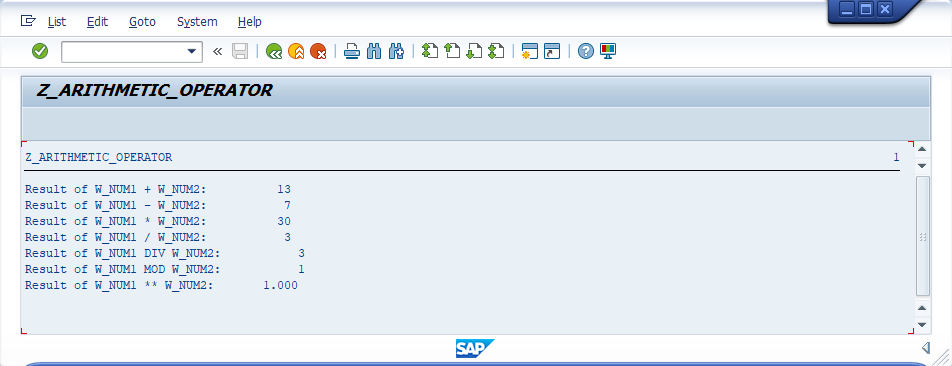SAP ABAP Arithmetic Operators
The arithmetic operators perform arithmetic claculations on two or more numeric operands. The result of arithmetic expression is a numeric value.
The arithmetic operators can be used to join an operand (operand1) with one or more operands (operand2, operand3 ...). Arithmetic expressions can occur on the right side of an assignment with the assignment operator =.
The arithmetic operators join two adjacent operands and the priority of the join depends on the operators used. Each operand can be preceded by the signs + or - in order to specify the sign of the value.
The arithmetic operators +, -, *, /, DIV, MOD, and ** use with two adjacent operands to produce a result.
Syntax -
[+|-] operand1
[{+|-|*|/|DIV|MOD|**} [+|-] operand2
[{+|-|*|/|DIV|MOD|**} [+|-] operand3
... ]].
Below table shows the list of the arithmetic operators -
| Operator | Name | Description | Order | Priority | Example |
|---|---|---|---|---|---|
| + | Addition | Addition of the operands | Left to right | 1 | 5 + 5 = 10 |
| - | Subtraction | Subtraction of the right operand from the left | Left to right | 1 | 5 - 5 = 10 |
| * | Multiplication | Multiplication of the operands | Left to right | 2 | 5 * 5 = 25 |
| / | Division | Division of the left operand by the right | Left to right | 2 | 5 / 5 = 1 |
| DIV | DIV | Division of the left operand by the right and produces the result as integer part. | Left to right | 2 | 77 DIV 5 = 15 |
| MOD | Modulus | Division of the left operand by the right and produces the result as positive remainder. | Left to right | 2 | 9 MOD 5 = 4 |
| ** | Power | Left operand raised to the power of the right | Right to left | 3 | 5 ** 4 = 625 |
Example -
Scenario - Below example shows how the arithmatic operations coded in the program.
Code -
*&---------------------------------------------------------------------*
*& Report Z_ARITHMETIC_OPERATOR
*&---------------------------------------------------------------------*
*& Written by TutorialsCampus
*&---------------------------------------------------------------------*
REPORT Z_ARITHMETIC_OPERATOR.
* Declaring variables
DATA: W_NUM1 TYPE I VALUE 10,
W_NUM2 TYPE I VALUE 3,
W_ADD TYPE I,
W_SUB TYPE I,
W_MUL TYPE I,
W_DIVI TYPE I,
W_DIV TYPE I,
W_MOD TYPE I,
W_POW TYPE I.
* Adding two variables
W_ADD = W_NUM1 + W_NUM2.
WRITE: 'Result of W_NUM1 + W_NUM2: ', W_ADD.
* Subtracting two variables
W_SUB = W_NUM1 - W_NUM2.
WRITE: /'Result of W_NUM1 - W_NUM2: ', W_SUB.
* Multiplying two variables
W_MUL = W_NUM1 * W_NUM2.
WRITE: /'Result of W_NUM1 * W_NUM2: ', W_MUL.
* Dividing W_NUM1 with W_NUM2
W_DIVI = W_NUM1 / W_NUM2.
WRITE: /'Result of W_NUM1 / W_NUM2: ', W_DIVI.
* Dividing W_NUM1 with W_NUM2 and produces the integer result.
W_DIV = W_NUM1 DIV W_NUM2.
WRITE: /'Result of W_NUM1 DIV W_NUM2: ', W_DIV.
* Dividing W_NUM1 with W_NUM2 and produces the positive remainder.
W_MOD = W_NUM1 MOD W_NUM2.
WRITE: /'Result of W_NUM1 MOD W_NUM2: ', W_MOD.
* W_NUM1 operand raised to the power of the W_NUM2.
W_POW = W_NUM1 ** W_NUM2.
WRITE: /'Result of W_NUM1 ** W_NUM2: ', W_POW.
Output -

Explaining Example -
In the above example, each and every statement is preceeded with a comment to explain about the statement. Go through them to get clear understanding of example code.
W_ADD = W_NUM1 + W_NUM2, adds W_NUM1, W_NUM2 values and stores result in W_ADD. W_SUB = W_NUM1 - W_NUM2, subtracts W_NUM2 from W_NUM1 and stores result in W_SUB.
W_MUL = W_NUM1 * W_NUM2, multiply W_NUM1 with W_NUM2 and stores result in W_MUL. W_DIVI = W_NUM1 / W_NUM2, divides W_NUM1 with W_NUM2 and stores result in W_DIVI.
W_DIV = W_NUM1 DIV W_NUM2, divides W_NUM1 with W_NUM2 and produces the integer result W_DIV. W_MOD = W_NUM1 MOD W_NUM2, divides W_NUM1 with W_NUM2 and produces the positive remainder W_MOD.
W_POW = W_NUM1 ** W_NUM2, W_NUM1 operand raised to the power of the W_NUM2 and stores the result in W_POW.
